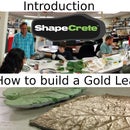Introduction: ShapeCrete-3D Printed Mold for a Votive Candle Holder
In this Instructable, we'll cover our first attempt to make a 3d-printed candle holder mold, for us to use with ShapeCrete, a nifty new concrete/clay like material (here is a link to their site).
We'll cover:
- 3D modeling a custom sized candle holder design, using a formula for any sized candle that is straight and round (and give an STL for you to download if you don't want to model it yourself)
- Printing the mold on 3D printer.
- Mixing ShapeCrete guidelines and tips (from our limited experience).
- Mold release and pouring.
- Enjoying your custom candle holders after a 24 hour cure.
Step 1: 3D Design and Coming Up With a Custom Size
The most common candle size is the one in the image above which I'm sure we have all seen before. You can buy a bag of 100 for a few dollars. If you're running low, this might be a great excuse to make a quick visit to your local Swedish flat-packed furniture warehouse. Yum, meatballs. Be right back...
---
Creating the hole for the candle:
You can apply this to most straight candles The radius of the candle and height (purple and blue lines) is what we will use to create our mold's dimensions. Just measure the dimensions of the diameter of the candle base (X) and choose a depth that you think would be good for your candle (T).
We are creating a cylindrical shape for our mold so that it can easily be removed. You will need to create a cavity to pour your mixture into, so we need to do everything in its "negative space". Make sure you always end up with a cavity in your mold at least the size of your (X and T), plus .5mm more for "wiggle room". It is important that you create a pool or cavity around your (X and T) with as this will be the area that solidifies.
After the 3D model is created in your software of choice, turn that baby into an .STL and export to your 3D printer.
We have included a .STL file for your convenience.
Attachments
Step 2: Printing and Mixing
Print your STL with your 3D printer. If you don't have a printer of your own, you can ask Google where to find a nearby makerspace that can help you out. Makerspaces are high-tech community workshops that usually have equipment like 3D printers, and will often give introductory classes that will show you how to work the machines. At HexLab, we offer free Intro to 3D Printing classes every few weeks.
You can print the mold in whatever plastic you have handy - since its just a mold, this is a good time to use up some plain filament or an ugly color that you want to get rid of. We like to use ABS, since after printing the mold, we can use acetone and a q-tip and rub it all over evenly in the cavity to create a smooth finish. But if you are printing in PLA, just make sure your mold is as clean as possible to make it easy to de-mold your object later.
ShapeCrete says to use a 3 to 1 mix for molds - thats 3 parts ShapeCrete and 1 part water. Stir with a strong stick you can throw away. It is easy to mix - just add all the powder and almost all the water. Mix thoroughly and at the end slowly add the last bit of water to get a good wet wet clay-like consistency.
Note: this stuff is a little messy, so put something down on your work surface to catch any spills and keep some rags around.
Step 3: Mold Release and Poring
Release agent: Spray some Pam or other spray cooking oil into the mold cavity, pour your prepared ShapeCrete in and tap the side of the mold repetitively to get rid of any bubbles. If you can vibrate the mold (with, um, something that vibrates, you know what I mean ?) it will help with this too.
Cover: Place some type of plastic (wrap, bag, sheet, etc) over your mold to keep in moisture during the curing process, which will help your piece look amazing.
Step 4: Take Out of Mold, and Repeat!
Great! All we need to do now is to wait 24 hours and our mold should come out with no problem. You can then mix up more ShapeCrete and make another copy.
ENJOY !!!
Tips:
Candle holder sticks in mold: If your part is stuck, glue a wood sliver or screwdriver to the base of the part and after curing turn it left and right in your mold. After it comes out, remove the screwdriver or wood.
Rough edges or glue left on mold from previous tip: Sand down or use a Dremel tool to clean up.
Mixing: if you have followed the mixing instruction correctly, then you must just need to stir longer.
Notes:
We did have some cracks in our piece, but that is due to not enough release agent, so we needed to pull hard to get it out.
Bubbles were present despite shaking, we recommend you mix it very well before pouring.














